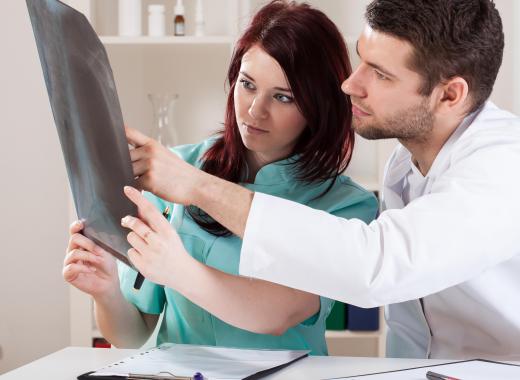A safelight is a lamp which produces light in areas of the spectrum which will not affect photosensitive materials like film and photographic paper. Safelights are used in darkrooms to provide light to work by without compromising the materials handled in the darkroom. While many people may associate red light with safelights, safelights actually come in a range of colors, and different types of photographic materials come with different safelight recommendations. It's important to follow these recommendations to avoid fogging or otherwise compromising these materials.
Safelights can work in one of two ways. Some consist of a housing with a holder for filters. Others consist of a bulb which has been coated in a material which will act as a filter. Some manufacturers of photographic supplies, such as Kodak, specifically recommend working with filtered safelights, because the filter blocks more of the potentially dangerous light. Both kinds are readily available from photographic suppliers, along with accessories like swivel mounts which allow people to turn a safelight for better lighting of a specific area in the darkroom.

One advantage to a filtered safelight is that it's easy to change the filter for specialized applications. If someone regularly works with a red safelight, for example, and a particular brand of photographic paper recommends amber instead, an amber filter can simply be inserted into the filter holder.
It isn't safe to work under a safelight indefinitely; prolonged exposure can damage photographic materials, primarily because sensitivity to light doesn't stop abruptly in one area of the spectrum, which means that the light from a safelight will eventually lead to fogging and other problems. Certain types of photographic material also cannot be used with any kind of light, requiring total darkness. Photographers and other people who work with photographic materials such as lithographic printers and x-ray technicians also need to be aware that safelight filters fade with time, which means that they can start to allow dangerous light through. Filter companies usually include recommendations about how often the filter should be changed, based on level of use, to ensure that the filter will be effective.
Amber and red are two popular colors for safelights. Recommendations on packaging for photographic materials usually include a color recommendation and a wattage recommendation, to ensure that people use bulbs of the appropriate brightness. It's also a good idea to change safelight bulbs regularly, because the bulbs can grow dimmer over time due to the deposition of materials on the inside of the bulb.
Ever since she began contributing to the site several years ago, Mary has embraced the exciting challenge of being a About Mechanics researcher and writer. Mary has a liberal arts degree from Goddard College and spends her free time reading, cooking, and exploring the great outdoors.

